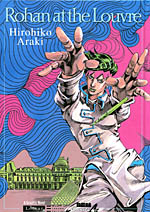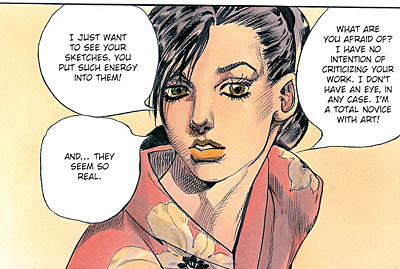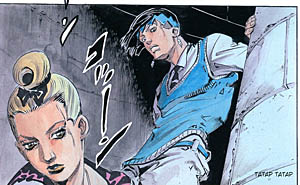 By Hirohiko Araki
By Hirohiko Araki
128 pages, color
Published by NBM
I’ve always loved the fact that the Louvre art museum in Paris has been commissioning a series a graphic novels set within and around the famed museum. Each one’s had a different take on the idea (my favorite is probably Museum Vaults by Marc-Antoine Mathieu) but they’ve all been good. With Rohan at the Louvre, the Louvre has hired a manga creator to tackle the subject. And what we got was not only able to stand out in its own right, but strong enough that now I want to read more comics by Araki.
Araki quickly introduces his character of Rohan—whom I hadn’t realized until after the fact is one that’s appeared in other short works by Araki, but you don’t need to have read those to enjoy this book—and his ability to "read" people’s souls, before leaping right into the plot itself. Araki crams a great deal of time into this book’s 128 pages; we start when Rohan is young and living at his grandmother’s boarding house, and end a decade later after he’s become a successful manga creator and decides to investigate a mystery that had begun all those years ago.  In some ways Rohan at the Louvre feels like two different graphic novels grafted together; the halves are tonally quite different from one another, the first being more of a gothic romance and the second being an out-and-out horror. But despite there being a strong dividing line between the two, the second half feeds off of what we learned in the first half in a way that makes this pair of stories work as a single unit.
In some ways Rohan at the Louvre feels like two different graphic novels grafted together; the halves are tonally quite different from one another, the first being more of a gothic romance and the second being an out-and-out horror. But despite there being a strong dividing line between the two, the second half feeds off of what we learned in the first half in a way that makes this pair of stories work as a single unit.
One of the things that I think works best about the jump in time between the two halves of Rohan at the Louvre is how Araki is able to make Rohan grow up a bit between the two. When Rohan interacts with the mysterious Nanase in the first half, he’s all but spying on her as he grows more and more intrigued by her story. He’s a slightly gawky teenager, with youthful ambition and dreams but not a lot of self-control. (After all, that’s partially why he’s staying at the guesthouse.) Once Rohan is older and in Paris, there’s a bit of maturity in him. He’s a big scornful of the teens that he runs into (although his mocking their outfit when in his own slightly bizarre uniform feels a bit off), but he’s someone for whom success has clearly managed to arrive for.
 The horror element in the second half of Rohan at the Louvre is strong and slightly unnerving, thanks in no small part due to Araki’s art. The art here reminds me of a mixture of Western artists like Barry Windsor-Smith and Neal Adams; there’s a strong sense of realism to the art, with heavy, strong ink lines. When Rohan and his escorts are being attacked in the bowels of the Louvre, the impossible elements are jarring in part because they’re drawn with that same level of realism that we’d seen up until that point. The tire tread moment is easily the most memorable of the actual death scenes, but what ends up being even creepier is the sideways glimpses of the dreaded Nizaemon Yamamura painting when they first arrive at vault Z-13. Araki carefully avoids letting us see it directly until almost the end of the entire book; by that point it’s built up so much menace that Araki has infused our own emotions into the final piece. We are able to understand its danger by what it can do, not just solely on how it looks at first glance.
The horror element in the second half of Rohan at the Louvre is strong and slightly unnerving, thanks in no small part due to Araki’s art. The art here reminds me of a mixture of Western artists like Barry Windsor-Smith and Neal Adams; there’s a strong sense of realism to the art, with heavy, strong ink lines. When Rohan and his escorts are being attacked in the bowels of the Louvre, the impossible elements are jarring in part because they’re drawn with that same level of realism that we’d seen up until that point. The tire tread moment is easily the most memorable of the actual death scenes, but what ends up being even creepier is the sideways glimpses of the dreaded Nizaemon Yamamura painting when they first arrive at vault Z-13. Araki carefully avoids letting us see it directly until almost the end of the entire book; by that point it’s built up so much menace that Araki has infused our own emotions into the final piece. We are able to understand its danger by what it can do, not just solely on how it looks at first glance.
Rohan at the Louvre is a fun book, and it’s one that grows on you with time. I enjoyed it when I first read it, but a day later I found myself thinking about it and how effective some of the scenes in the book were; not only the horror scenes, but the guesthouse interactions between Rohan and Nanase as well. I’d love to see more of Araki’s Rohan comics translated in to English, based on Rohan at the Louvre. All in all, another strong addition to the Musee du Louvre Edition line. Don’t let the garish colors on the cover of Rohan at the Louvre scare you off; this is a dark, creepy book.
Purchase Links: Amazon.com | Powell’s Books
